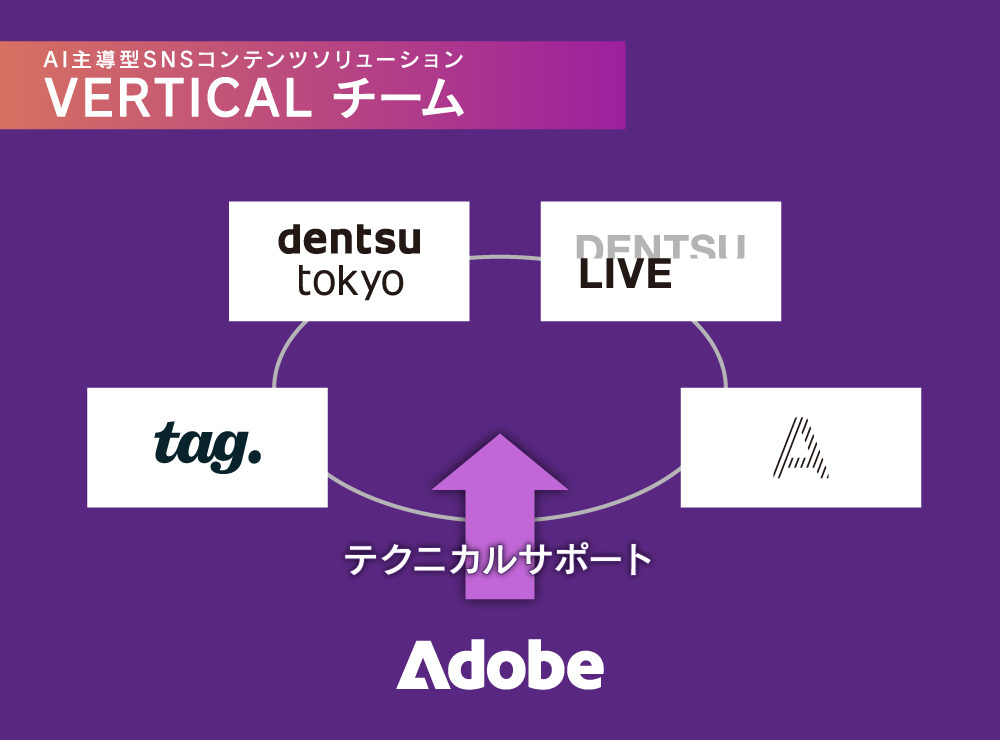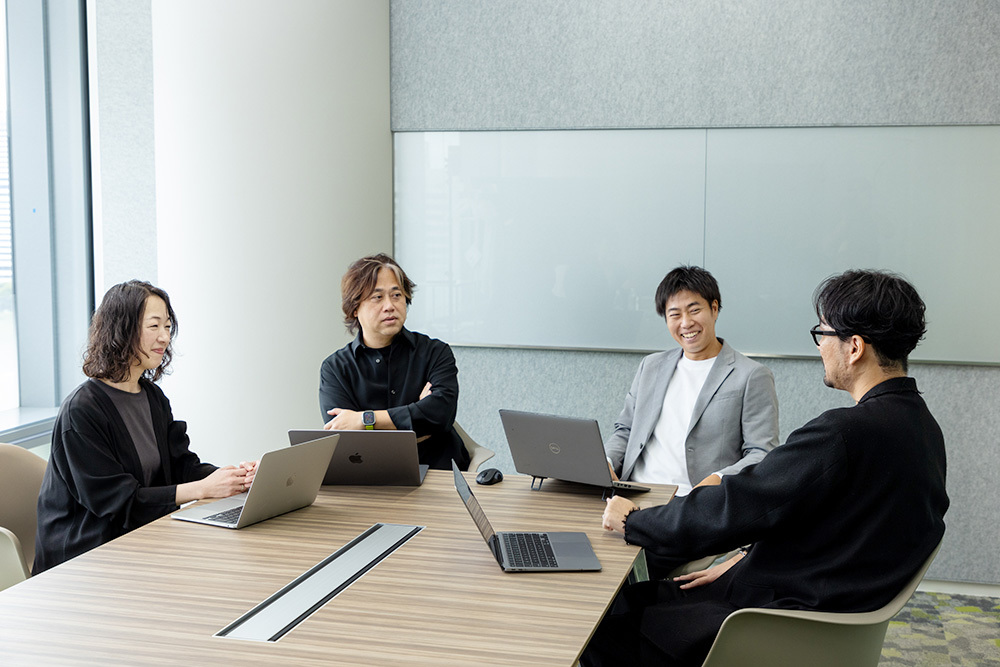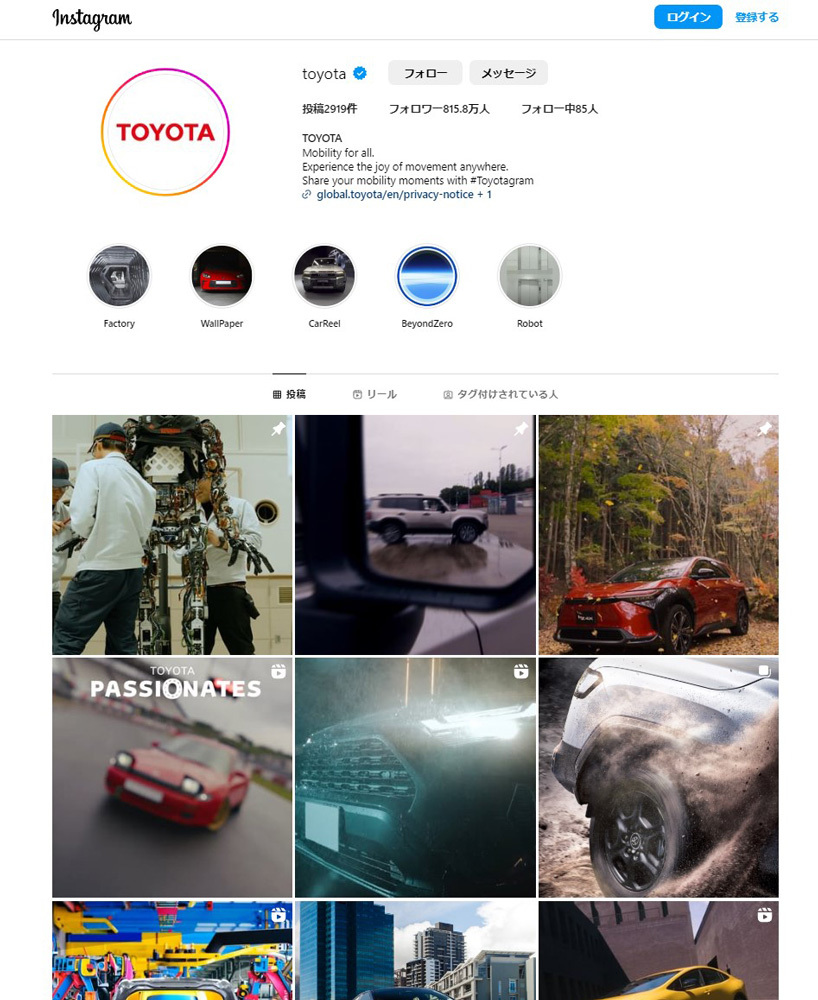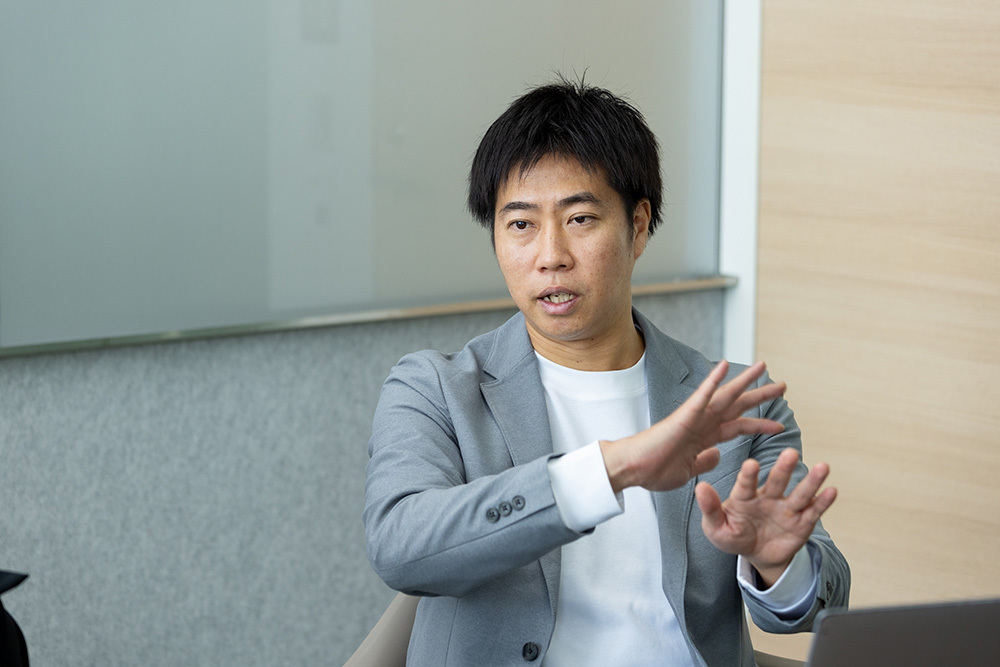
From left: Katsufumi Maezawa (Dentsu Live Inc.), Kaori Uno (Adobe), Toshihiro Iyoda (Dentsu Inc.), Midori Noguchi (Dentsu Inc.), and Sho Dejima (A Inc.). This article features insights from the four speakers excluding Ms. Noguchi.

VERTICAL: An AI-driven SNS marketing solution provided through a multi-company consortium
Short videos are now becoming mainstream in SNS marketing.
For brands expanding globally, using short videos to broaden their fanbase across countries is already considered the standard approach.
Amidst this trend, initiatives are emerging that actively leverage AI across every stage of short video campaigns—from competitor analysis and content creation to post-performance analysis. This initiative is called the AI-driven SNS marketing solution "VERTICAL." It is a consortium-based project involving multiple companies, including Dentsu Inc. and Dentsu Live Inc.
Members from Dentsu Inc., Dentsu Live Inc., Adobe, and A Inc. (Ace), all participating in VERTICAL, gathered to discuss the solution's future outlook.
*Note: During the roundtable, examples of SNS initiatives for Toyota Motor Corporation (hereinafter Toyota) undertaken by Dentsu Inc. and Dentsu Live Inc. were introduced. However, these examples predate the launch of "VERTICAL" and do not represent "VERTICAL" itself.
The Three Principles of Short Videos: "What is this!?", "The Opening 2-Second Hook", "Non-Verbal"

From left: Kaori Uno (Adobe), Katsufumi Maezawa (Dentsu Live Inc.), Toshihiro Iyoda (Dentsu Inc.), Sho Dejima (A Inc.)
──Today we're speaking with representatives from four companies participating in "VERTICAL." This is a consortium-style project—what is the structure like?
Iyoda: Dentsu Inc. and Dentsu Live Inc. lead SNS operations. Together with companies like Tag Inc. (part of the Dentsu Group) and our partner A Inc., which excel in analysis and content creation, we implement AI-driven marketing. Additionally, Adobe, a top player in enterprise AI solutions, provides AI solutions for content creation and offers supervision.
──Could each of you briefly introduce yourselves?
Iyoda: I'm a Business Producer at Dentsu Inc., responsible for Toyota's global marketing. For "VERTICAL," I primarily handle coordination with all involved companies, including the client.
Maezawa: I'm a Creative Director in the Content & Technology Development Department at Dentsu Live Inc., working on social media initiatives, digital content strategies, and AI initiatives. Since 2018, I've been involved in Toyota's global social media branding alongside Mr. Iyoda's team.
Uno: I'm a Manager in the Solution Consultant Team at Adobe's Corporate Sales Department. Specifically, I promote Adobe Creative Cloud products to clients among Japan's top 300 companies. "VERTICAL" also utilizes Adobe's generative AI solutions.
Dejima: I serve as COO at A Inc. Our company specializes in AI-powered analytics tools that dissect influencers, followers, and the true state of the market. At "VERTICAL," I primarily handle market and user analysis.
Maezawa: Incidentally, regarding the origin of "VERTICAL," the term "VERTICAL" signifies "vertical" in the sense of 9:16 aspect ratio vertical videos, and also embodies the meaning of rapidly advancing digital marketing through AI in a vertical launch approach.
──First, let's discuss the current challenges in social media marketing. I understand the impetus came from Toyota's global social media short video initiatives. What was the background behind this effort?
Iyoda: Toyota actively pursues global branding through SNS. Our team began content initiatives to brand Toyota on Instagram starting in 2018. Our goal at that time was to significantly increase Toyota's fans, specifically "the number of SNS followers."
Then, in 2020, the short video feature (Instagram Reels) was released, and we began strengthening our short video initiatives starting in 2022. This is because, in recent years, short videos have become the mainstream form of social media content, especially among younger audiences.
Maezawa: As of 2019, Toyota's global Instagram account had 315,000 followers. Through our work on content strategies, including short videos, within the Dentsu Group, we've now grown that number to over 8 million followers—roughly 25 times the original figure. However, European luxury car manufacturers have tens of millions of followers. While tackling the long-standing challenge of "Can't we increase Toyota's fan base even more?", the concept for the AI-driven social media marketing solution "VERTICAL" emerged.
VERTICAL is an experimental solution launched just now. In other words, it's not the sum of Toyota's efforts over several years; rather, all insights gained from Toyota's Instagram form the foundation of VERTICAL.

Toyota's global official Instagram account. Mr. Maezawa and his team have been refining their approach daily, gaining insights into short-form video content.
Iyoda: We see this follower count gap as stemming from differences in SNS marketing, particularly short videos. European manufacturers are perceived as "cool and stylish" even among younger demographics. Toyota has some ground to make up in the SNS space compared to European manufacturers. We wanted to change Toyota's brand image through short videos that young people can easily consume.
──What are the key characteristics of SNS marketing?
Maezawa: A major point is that many people viewing social media content leave within just 2 or 3 seconds. Also, unlike TV, social media is a medium users actively engage with, so overtly promotional content is avoided. It gets swiped past almost unconsciously and skipped.
Iyoda: Content that feels familiar or predictable also gets skipped and leads to drop-offs easily. The digital world is overflowing with content, so anything resembling something seen before or feeling formulaic gets easily overlooked.

Dentsu Inc., Mr. Iyoda
Maezawa: To grow followers with short videos, we needed to radically shift our approach from traditional TV commercial production methods. For instance, when creating content for TV or video, we tend to want to structure it with a clear beginning, development, turning point, and conclusion. But analyzing popular social media content across industries, including those with large fanbases, revealed that none of that exists. At the same time, we realized that short videos that get watched need a unique spice specific to social media, different from TV.
One key element is embedding something in the social media video content that makes users think, "What is this!?" – something that hooks them. Another is crafting the "first two seconds" of the video to grab their interest. The goal is to stop users' fingers as they unconsciously scroll through their feed with that initial impact. Interestingly, this critical window used to be said to be "the first three seconds," but it's getting shorter every year.
Iyoda: To add one more point, global-targeted creative tends to rely heavily on non-verbal communication. Since the audience is global, videos dependent on specific languages won't be watched. We aim for "video content that makes people feel rather than think." Toyota runs short video campaigns on Instagram precisely to deliver global content that resonates across all language regions worldwide. Therefore, we strive for content that appeals solely through high-quality visuals and sound.
We've entered an era where AI is indispensable for both content creation and data analysis.

Dentsu Live Inc., Mr. Maezawa
──Beyond content substance, what challenges do you perceive in social media marketing?
Maezawa: This relates to why we started "VERTICAL," but content creation for SNS is too time-consuming and labor-intensive. The cycle is short: create content quickly, observe and analyze the response, then create the next piece. Popular SNS accounts constantly post engaging content at a rapid pace. To keep up with that speed, we also challenge ourselves to post high-quality content frequently.
Data analysis has been particularly challenging. In data-driven social media marketing, analyzing content across industries and measuring user engagement post-publication is essential for creating content that gets seen. But manual efforts had their limits. That's why we consulted with Mr. Dejima at A Inc.—to solve the time and labor issues and visualize, through data, what kind of creative content is optimal.
Dejima: At A Inc., we develop solutions to reduce human burden as much as possible. That said, solutions alone aren't the whole answer. Human expertise is still needed to identify the key points for analysis.
──A Inc. specializes in social media marketing. Have you established any kind of winning formula?
Dejima: Well, social media changes incredibly quickly. Fundamentally, when social media users encounter content, they either:
"just viewing"
"tapping the like button"
"following"
These decisions are made almost unconsciously. In the past, we simply measured engagement by metrics like "number of likes," but the situation has changed recently. As Mr. Maezawa mentioned earlier, users who once watched at least the "first 3 seconds" now decide whether to leave within the "first 2 seconds." Lately, they're not even clicking "like" anymore. Judging whether content captures a user's interest is becoming harder every year.
Maezawa: Plus, video lengths are getting shorter and shorter. For example, a popular brand's social media account effectively posts short-form content around 6 seconds long, sometimes instantly reaching 3 million viewers. In that sense, the old rules won't apply going forward.
──User engagement is generally measured by metrics like "views," "shares," "likes," and "comments," but we're seeing changes there too. At A Inc. and Adobe, you're likely experiencing these shifting trends firsthand.
Dejima: Yes. We need to understand what kind of users are reacting to specific content and how. Someone might not press "like," but they could be intently focused on the content. That requires more sophisticated analysis using metrics like content dwell time and various other indicators.
Uno: Adobe also handles both content and data in its business, and we firmly believe content creation and data analysis are inseparable. Data—meaning user reactions—doesn't lie. Properly capturing that data and linking it back to content creation is becoming increasingly crucial.
Maezawa: Tag Corporation, participating in "VERTICAL," possesses "heatmap analysis" technology that measures and identifies which parts of short videos users focus on and to what degree. It analyzes content results, not just numerical data like view counts. Analysis at this level is becoming essential for SNS marketing.
AI covers areas impossible for humans alone
──On the other hand, the more important data analysis becomes, the more we hit limits relying solely on human effort, right?
Maezawa: Yes. And why is it that humans, who should be focusing on creative work, end up bogged down by labor-intensive tasks like data collection and analysis? That's why we consulted A Inc., which specializes in SNS marketing. I was surprised when Mr. Dejima immediately replied, "For SNS analysis, you can easily do it with AI."
Dejima:We'll explain our analysis tool in the next session, but simply put, it analyzes "psychographic information"—such as the interests and brand preferences of influencers' followers across each SNS platform.
──Also, "VERTICAL" emphasizes AI utilization not just in the analysis phase but also in the creative phase, right?
Maezawa: For creative work, just like data analysis, we wanted to separate the points where humans should focus from the tasks we could entrust to AI. Furthermore, regarding AI technology that supports human creativity, I believe Adobe continues to lead the industry in the safety of AI usage.
Uno: Traditionally, in every field, it was standard for humans to create content entirely from scratch. Now, by leveraging AI, we can create diverse content. From an efficiency perspective, as we can delegate repetitive or simple tasks to generative AI, the way we create content changes. The idea is to have AI assist us so humans can secure proper time and better unleash their creativity.
──What AI solutions does Adobe offer?
Uno: One is Adobe Sensei, which we've long provided as AI support optimized for individual creators. Then there's Adobe Firefly, our image generation AI, which we also offer as an integrated feature within existing services like Photoshop and Illustrator. Adobe has also operated Adobe Stock, a stock photo and illustration service, for many years. This allows us to generate high-quality images using training data that is free from rights issues.
Maezawa: When using generative AI for business, Adobe products offer peace of mind, right?
Uno: In the year and a half since Firefly's release, it has generated a staggering 13 billion pieces of image content. This usage surpasses any previous Adobe feature. The reason is that generative AI has expanded Adobe tools beyond creators to all business professionals. Marketers and IT personnel now use them too, truly advancing the "democratization of creativity" – an era where anyone can create content.
──Thank you. Next time, we'll finally hear about the full scope of "VERTICAL"!
(Continued in Part 2 )


















